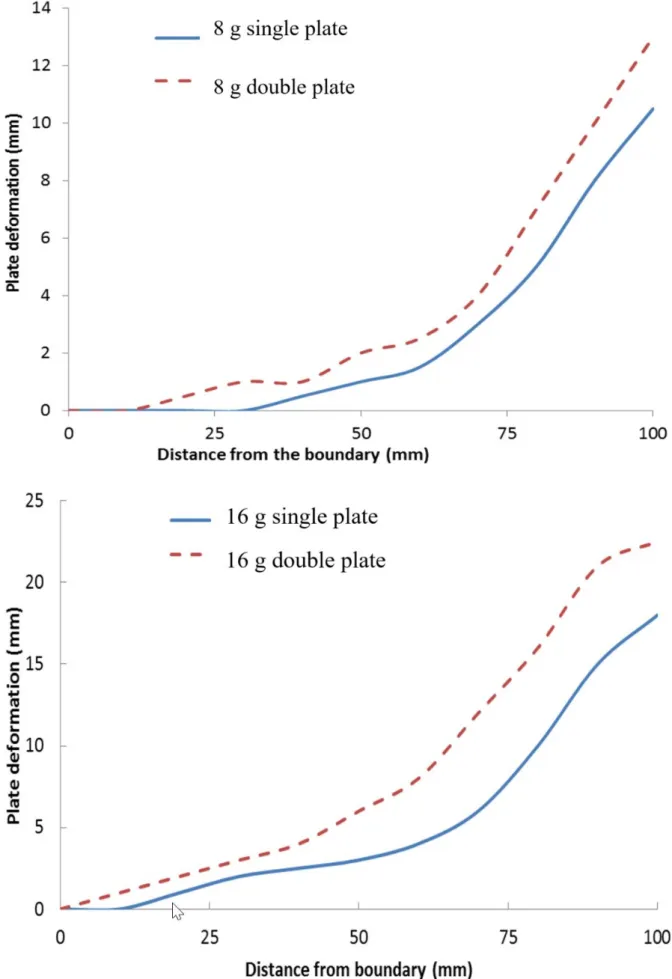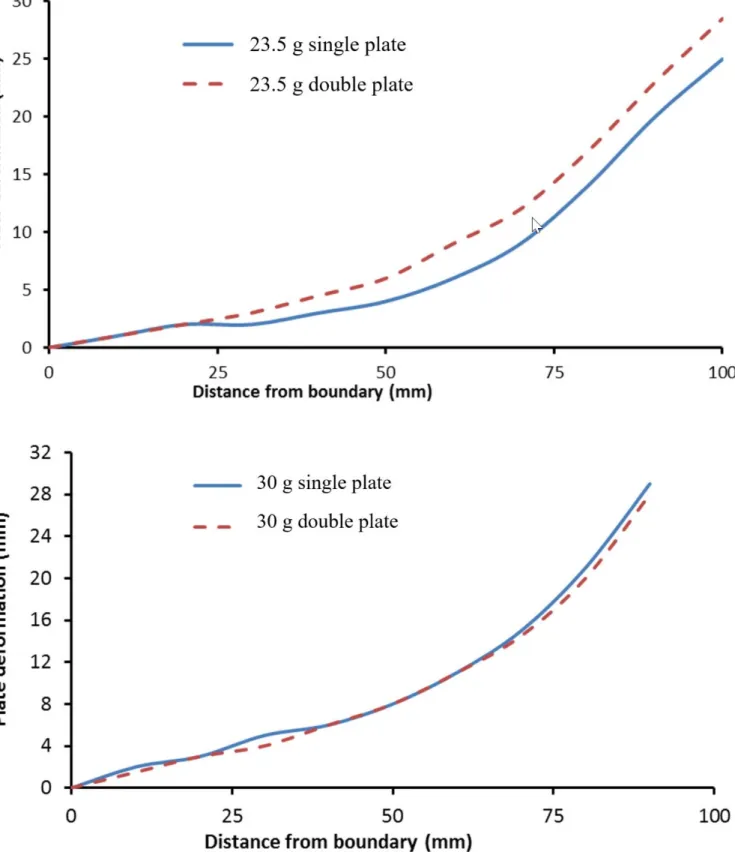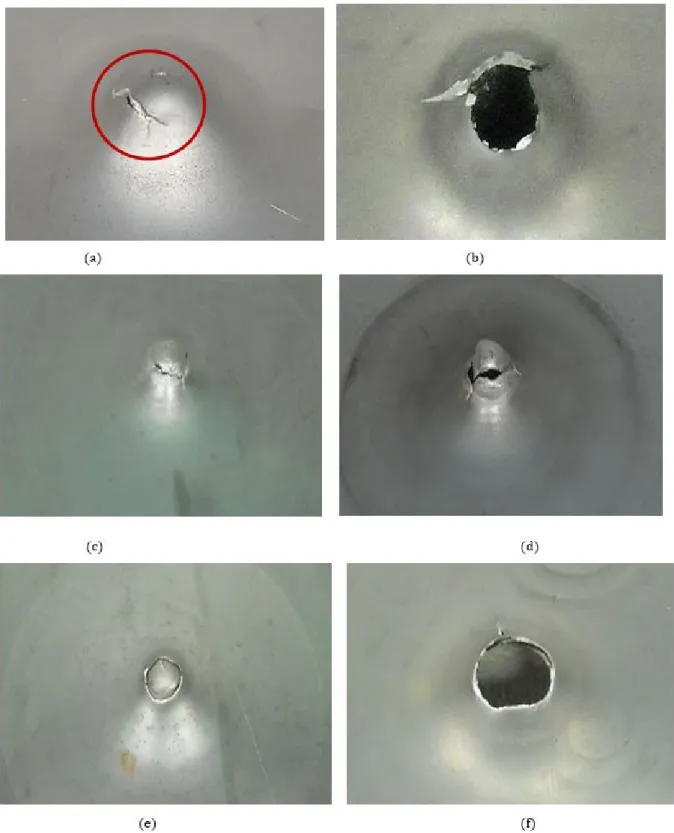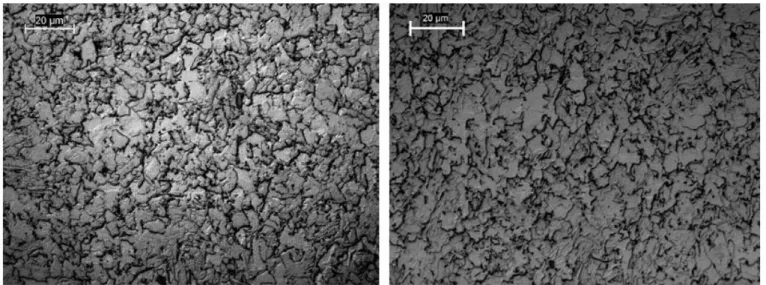A study on the response of single and double circular plates subjected
to localised blast loading
Abstract
The response of single and double layered steel plates to localised air-blast loading was examined. Two configurations, both comprising fully clamped circular plates with a 200 mm exposed diameter, were considered: 4mm thick single and 2 2 mm double layered plates. The localised air-blast loading was applied by centrally detonating discs of PE4 plastic explosive. Similar failure modes were evident in the single and double plate configura-tions, namely, Mode I large inelastic deformation and Mode II capping failure along with deformation responses. The double plates exhibited larger midpoint deflections than the single plates, and partial tearing of the front plate in the double plates was observed at a lower impulse than in the single plates. However, complete capping of both plates in the double plate configuration occurred at the same charge mass as for the single plates, im-plying that both configurations offer equivalent protection from capping failure as a result of this type of localised blast loading. A metallographic study of the deformed and torn plate regions did not reveal any phase trans-formation in the steel. It was also found that the 2 mm thick plates exhibited larger increases in grain size than the 4 mm thick plates.
Keywords
Blast loading; plates; HSLA steel; deformation; Microstructure
1 INTRODUCTION
Conventionally, High Strength Low Alloy HSLA steels are considered as a basic construction material for ar-mour systems due to their high hardness and enhanced yield strengths. In recent years, the potential of multi-lay-ered plates to improve the performance of structures subjected to projectile impact has been investigated by vari-ous researchers.
Marom and Bodner 1979 performed ballistic tests on layered targets of 6061-T aluminium alloy beams us-ing 0.22 calibre projectiles at a velocity of 375 m/s and found that equivalent mass multi-layered beams were more effective in resisting perforation than single beams. Corran et al. 1983 tested mild steel, stainless steel and alu-minium plates and showed that layered shielding exhibited superior ballistic resistance to a single plate once the total thickness exceeded a critical value. Woodward and Cimpoeru 1998 reported results from impact tests using conical and blunt nosed projectiles on layered 2024-T351 aluminium plates. The layered system comprising two plates of equal thickness provided the highest ballistic limit for both nose shapes.
However, Radin and Goldsmith 1988 reported results from normal impact tests on multi-layered targets of different thickness and showed that the ballistic resistance of the equivalent mass single target was greater than that of the layered systems. Similarly, Almohandes et al. 1996 found that single plates were more effective than laminated plates when impacted by 7.62 mm standard bullets, in the thickness range 1-8 mm. Plates comprising fewer laminates were more effective than those containing many laminates. Zukas and Scheffler 2001 also con-cluded that layering reduced the ballistic performance of systems when the overall thickness was relatively low.
Teng et al. 2007 ; Teng et al. 2008 reported results from a numerical study on the protection performance of double-layered metal shields against different projectile using ABAQUS/Explicit. The study indicated improved ballistic resistance of 8–25% by using double-layer configuration against flat-nose projectile. Dey et al. 2007 found that double-layering the target caused an increase of 40 – 50% in ballistic limit velocity V50 compared to a single target of equal thickness when impacted by blunt projectiles. In case of ogival nose projectile, the single target offered better protection, but the difference in perforation resistance was only 10– 15%.
M. Saeed Ahmada G. S. Langdona G. N. Nuricka S. Chung Kim Yuena*
a Blast Impact and Survivability Research Unit
BISRU , Department of Mechanical Engineering, University of Cape Town, Rondebosch, 7701, South Africa. E-mail: msaeed66@gmail.com, ge-nevieve.langdon@uct.ac.za,
gerald.nu-rick@uct.ac.za, steeve.chungkimyuen@uct.ac.za
*Corresponding author
http://dx.doi.org/10.1590/1679-78255246
sponse in layered plates is the reason for the improved ballistic limit – the ductile structures were able to absorb more energy before rupturing than the equivalent mass brittle plates Dey et al. 2007 . However, not all multi-layered structures exhibited enhanced impact performance, as the relative performance was dependent upon var-ious factors, including the projectile geometry and the overall thickness of the protective structure. Since layered steel plates have been shown to give improved ballistic performance under certain circumstances Dey et al. 2007 ; Teng et al. 2007 ; Teng et al. 2008 , it is useful to ascertain the effect of layering for blast performance. There have been many investigations into the blast performance of single steel plated structures to localised blast loading, for example references Chung Kim Yuen and Nurick 2000 ; Jacob et al. 2004 ; Nurick and Radford 1997 . The authors are unaware of similar investigations into the blast response of multi-layered steel plates, except for some attempts at tuning blast/impact response through layering of a thick armour structure to modify the stress wave transmission through the plates by choosing materials with differing damping frequencies, for example Rahimza-deh et al. 2015 .
The failure modes of structures subjected to uniformly distributed blast loading were first classified by Menkes and Opat 1973 at various intensities of impulse. Similar failure modes were also observed for clamped circular plates Teeling-Smith and Nurick 1991 and for square plates Nurick and Shave 1996 ; Olson et al. 1993 sub-jected to uniform blast loads. Nurick and Radford 1997 reported that localised blast loading resulted in plate deformation that was characterised by an inner dome superimposed on a larger global dome. At higher impulses, tearing in the central area of the plate occurred with further increase in impulse after the onset of thinning. The tearing observed was characterized by a cap torn away from the plate. The “capping” failure Mode was subdivided by Nurick and Radford 1997 .
Mode I - large inelastic response
Mode Itc - large inelastic response with thinning in central area Mode II*c - partial tearing in the central area
Mode IIc - complete tearing in the central area - capping Mode II - complete tearing at the boundary
This article presents preliminary results from blast loading experiments on layered plates and equivalent thickness single steel plates subjected to localised air-blast loading. These results are part of a wider study planned to consider the influence of layering in plates of different thicknesses. In the present study, the failure modes and deformation profiles of single and double plates with a combined thickness of 4 mm were compared. Results from air-blast loading experiments on Domex 550 MC steel plates in two configurations, namely, single 4mm thick and double plates of equal thickness 2 2 mm, the post-test inspections and metallographic investigations are re-ported.
2 MATERIAL TESTS
High-strength low-alloy HSLA steels are a group of low-carbon steels that use small amounts of alloying ele-ments to attain higher yield strengths in the as-rolled or normalised condition. These steels have higher strength than as-rolled carbon steels and are usually 20 to 30% lighter than carbon steel with the same strength. The high yield strength can be obtained at lower carbon content levels. The weld-ability of many HSLA steels is comparable to or better than that of mild steel Society 1982 . Hence, HSLA steels are used in a wide variety of applications, such as cars, cranes, bridges, roller coasters. The properties can be tailored to specific applications by the combina-tion of composicombina-tion and structures obtained during processing. These steels have fine grain size microstructure due to micro alloying of Vanadium, Niobium and Titanium. The yield strength usually varies with grain size according to the well-known Hall-Petch equation, shown in Eq. 1 . Fine grains have larger grain boundary areas that impede dislocation motion. Domex 550MC is a hot rolled, cold forming steel that is produced by a thermo-mechanical treat-ment process and meets the demands for steel S550MC in EN 10149-2 SSAB, 2018 Last access Aug 2018 . The chemical composition of Domex 550MC steel is listed in Table 1.
𝜎𝑦 𝜎𝑜 𝐾𝑦/√𝑑 1
Table 1: Chemical composition of Domex 550MC steel SSAB Last access Aug 2018
Elements Wt. % Elements Wt. % Elements Wt. % Iron 97 Carbon 0.12 Aluminium 0.015 Manganese 1.80 Silicon 0.1 Sulphur 0.010
Vanadium 0.2 Niobium 0.09 Titanium 0.15 Phosphorus 0.025
The mechanical properties of the Domex 550MC steel were determined according to the ASTM standards Standard 2013 . The samples were cut from 2mm thick steel plates and were tested at a nominal strain rate of 4.2 10-4 /s on a Zwick universal testing machine. Three samples were tested at each cross-head speed. The average mechanical properties were: 533 MPa yield strength, a 605 MPa ultimate tensile strength and a 20% elongation to failure. Hardness tests were performed on samples prepared for metallographic study and the average hardness was 230 HV.
3 BLAST EXPERIMENTS
All tested plates were used in as-received condition. The 400 mm by 400 mm square plates were bolted be-tween two 12mm thick annular steel clamps with an exposed diameter of 200 mm. The annular clamps acted as a rigid boundary and fixed the plate to the ballistic pendulum. The whole clamped assembly was mounted in front of the ballistic pendulum, similar to previous blast loading experiments reported in Chung Kim Yuen and Nurick 2000 ; Jacob et al. 2004 ; Nurick and Radford 1997 ; Nurick and Shave 1996 ; Teeling-Smith and Nurick 1991 . A photograph of the ballistic pendulum and attached target plates is shown in Figure 1.
Figure 1: Photograph of test plate attached to ballistic pendulum
Table 2: Results of 4mm monolithic plate subjected to localised blast loading
Test No Charge mass g Impulse
Ns Permanent midpoint deflection mm SA041209SA 7 1 8 22.0 10.4
SA041209SB 15 1 16 38.1 17.9 SA041209SC 22.5 1 23.5 45.4 24.4 SA081209SD 29 1 30 57.7 29.5
Partial tearing SA151209SE 36.5 1 37.5 63.4 Hole Ø 20 - 22mm
Table 3: Results of 4mm 2 2 double plates subjected to localised blast loading
Test No Charge mass
g Impulse Ns Permanent midpoint deflec-tion of front plate mm Permanent midpoint deflec-tion of back plate mm SA071209DG 7 1 8 20.2 12.3 12.8
SA071209DH 15 1 16 36.1 21.8 22.5 SA071209DI 22.5 1 23.5 45.6 28.0 28.7 SA151209DJ 29 1 30 59.9 30.5
partial tearing Capped SA151209DK 36.5 1 37.5 61.0 Capped
Hole Ø 28.5 Hole Ø 29.5 Capped
3.1 Post-test failure inspection
Photographs showing mid-line cross-sections of the blast tested plates in single and double configurations with increasing impulses from bottom to top are shown in Figures 2 and 3, illustrating the deformation and tear-ing behaviour at various charge masses. Large inelastic deformation in both configurations increased with increas-ing impulse. The permanent midpoint deflections, measured usincreas-ing a height gauge, of double plates are slightly greater than the single plates as shown in Tables 2 and 3.
A laser scanner was used to capture the deformed shape of the plate. The deformation profiles from the bound-ary to midpoint were extracted from the data. Figure 4 shows the deformation profiles of the single plates. At low impulses 22 Ns , the deformation was limited to the central portion of the plate, while at higher impulses the deformation extended towards the boundary. Figure 5 shows the deformation profiles of double plates where the displacements were less localised, with higher displacements near the boundary when compared to the single plate profiles in Figure 4 . It is observed from Figure 3 that the deformed profile shape for the front and back plates were very similar until the point of fracture, varying by less than 1 mm. It was, hence, considered unnecessary to replicate the displacement profiles in another figure for the back sheet.
Failure Mode I large inelastic response and Mode Itc large inelastic response with thinning in central area responses were observed. At lower impulses below 36 Ns, no significant thinning was observed that is, Mode I failure occurred . Above 36 Ns, the thinning was observed in the central plate region, agreeing with observations in ref 10 , over a diameter smaller than the charge diameter that is, Mode Itc was observed . Reduction in thick-ness was easier to observe in the thicker single plate, as shown in the cross-section photographs in Figure 2.
Partial tearing in both single and double plates was found at higher impulses 45-60 Ns over a 29 mm diam-eter circular ring smaller than the charge diamdiam-eter . As tearing commenced and impulse increased, the defor-mation profiles of the two configurations are similar in both shape and magnitude, as shown in Figure 7b. For dou-ble plates, the front plate exposed to charge was partially torn that is, Mode II* whilst the back plate exhibited capping. Photographs of the double plate response are shown in Figures 8d and 8e. Although the double plates exhibited Mode II*c failure in the front plate at a lower charge mass, the complete rupture of single and double plate configurations occurred at the same charge mass 37.5 g . This means that the single and double layered configu-rations offer the same protection from this type of localised air-blast loading.
Mode IIc complete tearing was noted for impulses above 60 Ns as shown in Figure 8f for the double plate and Figure 8b for the single plate. The cap diameters were smaller in the single plates from 20 mm to 22 mm compared to the double plate cap diameters 28.5 mm to 29.5 mm . The holes in double plates were more rounded whereas the single plates exhibited petalling type failure. Boundary thinning and tearing were not observed during the present study due to the localised nature of the loading.
Figure 2: Photographs of the cross-sections of blast tested single plates
Figure 3: Photographs of cross-sections of blast tested double plates I=63.4 Ns, 37.5 g
I=57.7 Ns, 30 g
I=45.4 Ns, 23.5 g I=22 Ns, 8 g I=38.1 Ns, 16 g
I=61 Ns, 37.5 g I=59.9 Ns, 30
Figure 4: Deformed plate profiles for single plates subjected to blast loading
Figure 8: Photographs of plates exhibited partial tearing or capping failures a Single plate, 30 g PE4 b Single plate, 37.5 g PE4 c Double, front plate, 23.5 g PE4 d Double, front plate, 30 g PE4 e Double, back plate, 30 g PE4 front
plate showing under the back plate f Double, back plate, 37.5 g PE4
3.2 Metallographic observations
lographic techniques. In order to reveal different phases, polished samples were etched in a 2% nital solution for approximately 35 seconds.
The microstructure of virgin 4 mm and 2 mm thick plates, shown in Figure 9 a and Figure 10 a respectively, consisted of fine equi-axed grains of ferrite and a minute quantity of pearlite at the grain boundaries. Figures 9 b, c, d and Figures 10 b, c, d show the microstructures of deformed grains from plate samples subjected to increas-ing impulses. These deformed grains are due to plastic deformation durincreas-ing blast loadincreas-ing. The grain size was meas-ured along the deformation direction radially towards the charge diameter to study the effect of increasing im-pulses on microstructures.
The average grain sizes of the as-received 4mm thick plates were larger than the 2mm thick plates 7.5 and 4 microns respectively . The average grain size of the 4 mm and 2 mm thick samples from plates subjected to different impulses are shown in Tables 4 and 5 respectively. In the case of double 2 mm thick plate, the grain size of both the front and back plates were measured. No significant differences in grain size were observed. The deformed grain sizes of the 4 mm and 2 mm thick back plates were found be similar to each other, and increased with increasing charge mass. A graph of mid-point deflection thickness ratio versus normalised grain size, shown in Figure 11, in-dicated that the initial increase in grain size of 2 mm back plate was greater than of 4mm thick plate. The final grain size was similar in both plates when approaching capping failure. The normalised grain size increases in the plates were linear with increasing impulse, as shown in Figure 12. In case of 2 mm thick back plates, the initial increase in grain size is greater than in 4 mm thick plates, whereas at higher impulses increase in grain size is linear with the impulse as shown in Figure 12.
The plate microstructures along the capped edges were mainly composed of a ferritic phase, as shown in Figure 9 d and Figure 10 d . There was no evidence of a transformed region in microstructure as a result of heat gener-ated during tearing, unlike that reported by Raftenberg and Krause 1999 . The modelling of localised blast loaded mild steel plates reported by Langdon et al. 2005 and Wiehahn et al. 2000 assumed adiabatic heating and used temperature to define the onset of Mode IIc failure in the plates; both Wiehahn et al. 2000 and Langdon et al. 2005 reported maximum temperatures of 765 °C in the torn regions while 650 °C was considered to represent the torn regions. The microstructural findings herein indicate that the actual temperatures in the torn regions of the plates presumed to be due to adiabatic heating did not reach the melting temperature.
Table 4: Average grain sizes of 4mm single plate measured radially towards the plate centre
Charge mass g Average grain size
microns Standard Devi-ation Maximum grain size microns
Minimum grain
size microns Normalised grain size
As-received 7.5 1.9 12 4 1
7 1 8 9 2.2 25 6 1.2
15 1 16 11 3.4 21 7 1.5
22.5 1 23.5 12 3.8 22 7 1.6
29 1 30 13 4.5 24 5 1.7
Figure 10: Microstructures of 2 mm thick back plate subjected to various charge mass detonations etched in 2% nital
Table 5: Average grain sizes of 2 mm thick back plate measured radially towards the plate centre
Charge mass g Average grain
size microns Standard Devia-tion Maximum grain size microns Minimum grain size micron Normalised grain size
As-received 4 1.6 11 3 1
7 1 8 10 2.46 16 6 2.4
15 1 16 --- --- --- --- ----
22.5 1 23.5 13.3 3.6 21 6 3.2
29 1 30 14.3 3.9 23 8 3.4
36.5 1 37.5 15.1 4.1 23 8 3.5
Figure 11: Graph of grain size versus mid-point deflection thickness ratio
Figure 12: Graph of normalised grain size versus impulse
4 CONCLUSIONS
found that the 2 mm thick plates exhibited larger increases in grain size than the 4 mm thick plates.
Acknowledgements
The authors would like to acknowledge Penny Louw of the Centre of Materials Engineering for helping in metallography and mechanical testing, and the contributions of Reuben Govender and Victor Balden of the Blast Impact and Survivability Research Unit BISRU , University of Cape Town, for the valuable assistance during blast experiments. The authors are grateful to the UCT University Research Committee and the National Research Foun-dation NRF of South Africa for their financial support. Opinions expressed and conclusions arrived at, are those of the authors and are not necessarily to be attributed to the NRF.
References
Almohandes, A.A., Abdel-Kader, M.S., Eleiche, A.M., 1996 . Experimental investigation of the ballistic resistance of steel-fiberglass reinforced polyester laminated plates. Composites Part B: Engineering 27, 447-458.
Balden, V.H., Nurick, G.N., 2005 . Numerical simulation of the post failure motion of steel plates subjected to blast loading. International Journal of Impact Engineering 32, 14-34.
Chung Kim Yuen, S., Nurick, G.N., 2000 . The significance of the thickness of a plate when subjected to localised blast load. 16th International Symposium on Military Aspects of Blast and Shock, MABS 16 , 491-499.
Corran, R.S.J., Shadbolt, P.J., Ruiz, C., 1983 . Impact loading of plates — An experimental investigation. International Journal of Impact Engineering 1, 3-22.
Dey, S., Børvik, T., Teng, X., Wierzbicki, T., Hopperstad, O.S., 2007 . On the ballistic resistance of double-layered steel plates: An experimental and numerical investigation. International Journal of Solids and Structures 44, 6701-6723.
Jacob, N., Chung Kim Yuen, S., Nurick, G.N., Bonorchis, D., Desai, S.A., Tait, D., 2004 . Scaling aspects of quadrangular plates subjected to localised blast loads - experiments and predictions. International Journal of Impact Engineering 30, 1179-1208.
Langdon, G.S., Chung Kim Yuen, S., Nurick, G.N., 2005 . Experimental and numerical studies on the response of quadrangular stiffened plates -Part II- subjected to localised load. International Journal of Impact Engineering 31, 85-111.
Marom, I., Bodner, S.R., 1979 . Projectile perforation of multi-layered beams. International Journal of Mechanical Sciences 21, 489-504.
Menkes, S.B., Opat, H.J., 1973 . Tearing and shear failures in explosively loaded clamped beams. Experimental Me-chanics 13, 480-486.
Nurick, G.N., Radford, A.M., 1997 . Deformation and tearing of clamped circular plates subjected to localised cen-tral blast loads. Recent developments in computational and applied mechanics: a volume in honour of John B. Mar-tin, 276-301.
Nurick, G.N., Shave, G.C., 1996 . The deformation and tearing of thin square plates subjected to impulsive loads-an experimental study. International Journal of Impact Engineering 18, 99-116.
Radin, J., Goldsmith, W., 1988 . Normal projectile penetration and perforation of layered targets. International Journal of Impact Engineering 7, 229-259.
Raftenberg, M.N., Krause, C.D., 1999 . Metallographic observations of armor steel specimens from plates perfo-rated by shaped charge jets. International Journal of Impact Engineering 23, 757-770.
Rahimzadeh, T., Arruda, E.M., Thouless, M.D., 2015 . Design of armor for protection against blast and impact. Jour-nal of the Mechanics and Physics of Solids 85, 98-111.
Society, A.W., 1982 . Welding Handbook, Metals and their Weldability.
Standard, A., 2013 . Standard Test Methods for Tension Testing of Metallic Materials, Desingation: E8/E8M 13.
Swedish Steel SSAB , S.S., Last access Aug 2018 . http://www.ssab.com.
Teeling-Smith, R.G., Nurick, G.N., 1991 . The deformation and tearing of thin circular plates subjected to impulsive loads. International Journal of Impact Engineering 11, 77-91.
Teng, X., Dey, S., Borvik, T., Wierzbicki, T., 2007 . Protection performance of double-layered metal shields against projectile impact. Journal of Mechanics of Materials and Structures 2.
Teng, X., Wierzbicki, T., Huang, M., 2008 . Ballistic resistance of double-layered armor plates. International Journal of Impact Engineering 35, 870-884.
Wiehahn, M.A., Nurick, G.N., Bowles, H.C., 2000 . Some insights into the mechanism of the deformation and tearing of thin plates at high strain rates incorporating temperature dependent material properties. Structures Under Shock and Impact VI SUSI VI , 207-220.
Woodward, R.L., Cimpoeru, S.J., 1998 . A study of the perforation of aluminium laminate targets. International Journal of Impact Engineering 21, 117-131.









